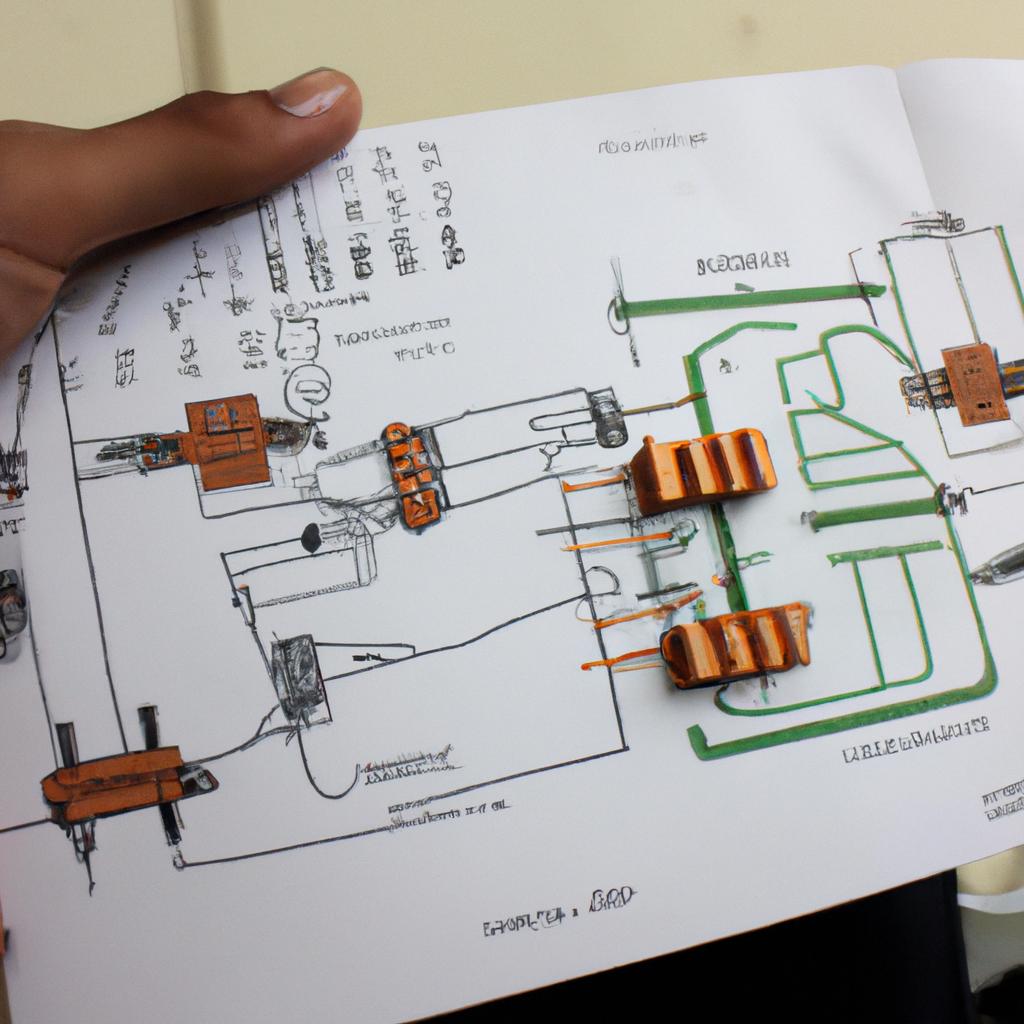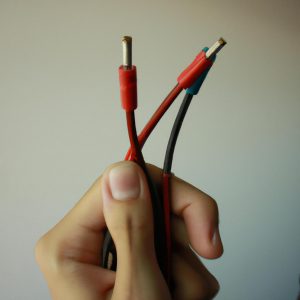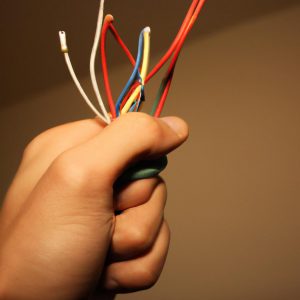Ohm’s Law: Electricity in Physics Directories

Ohm’s Law is a fundamental principle in the field of electricity and plays a crucial role in understanding its behavior and properties. This law, named after German physicist Georg Simon Ohm, establishes a direct relationship between voltage, current, and resistance in an electrical circuit. By utilizing this law, engineers and scientists are able to accurately predict and analyze various aspects of electrical systems.
To illustrate the significance of Ohm’s Law, let us consider a hypothetical scenario where an electrician is tasked with determining the appropriate size of wire for a residential building project. In order to ensure safety and efficiency, it becomes essential to understand how different factors affect the flow of electricity through the wires. By applying Ohm’s Law, the electrician can calculate the required voltage drop across each section of wire based on the desired current flowing through it. This knowledge allows them to select the appropriate gauge of wire that will minimize power loss due to excessive resistance while maintaining optimal performance.
With its wide-ranging applications in fields such as electronics, telecommunications, and power distribution systems, Ohm’s Law serves as a cornerstone for understanding the behavior of electrical circuits. Through careful analysis and calculation using this law, professionals are empowered to design efficient systems and troubleshoot issues when they arise. In this article , we will explore the various applications of Ohm’s Law in different industries and discuss how it can be used to solve practical problems. Additionally, we will delve into the mathematical equation behind Ohm’s Law and explain how it relates voltage, current, and resistance. Whether you are a student studying electrical engineering or someone simply interested in understanding the basics of electricity, this article will provide you with a comprehensive overview of Ohm’s Law and its significance in the world of electrical systems.
What is Ohm’s Law?
Ohm’s Law is a fundamental principle in the field of physics that describes the relationship between current, voltage, and resistance in an electrical circuit. It provides a mathematical formula to calculate one variable when two others are known. Named after German physicist Georg Simon Ohm, this law has significant implications for understanding how electricity flows through conductors.
To illustrate the significance of Ohm’s Law, let us consider a hypothetical scenario. Imagine we have a simple circuit consisting of a battery connected to a light bulb using wires. The light bulb represents the load or resistor in the circuit, while the battery acts as the source of electrical energy. By applying Ohm’s Law, we can determine how much current will flow through the circuit based on the applied voltage and the resistance of the light bulb.
Understanding Ohm’s Law allows us to comprehend various phenomena related to electricity more effectively. Here are some key points about Ohm’s Law:
- Predictability: Ohm’s Law enables engineers and scientists to predict and control electric currents accurately.
- Circuit Analysis: By utilizing this law, experts can analyze complex circuits and troubleshoot issues efficiently.
- Safety Considerations: Understanding Ohm’s Law helps ensure safe practices when working with electrical systems by providing insights into potential hazards.
- Application Diversity: This principle finds applications not only in electronics but also in fields such as telecommunications, power distribution networks, and renewable energy systems.
Let us now delve deeper into key components of Ohm’s Law without further ado
Key Components of Ohm’s Law
Section H2: Understanding Ohm’s Law
Ohm’s Law is a fundamental principle in physics that relates the current flowing through a conductor to the voltage applied across it and the resistance of the conductor. This law, named after German physicist Georg Simon Ohm, provides valuable insights into the behavior of electricity in various systems. To better understand this concept, let’s consider an example:
Imagine a simple circuit consisting of a battery connected to a resistor. When we increase the voltage supplied by the battery, we observe that the current flowing through the resistor also increases. Conversely, when we decrease the voltage, the current decreases as well. This relationship between voltage and current can be mathematically expressed using Ohm’s Law.
To further explore Ohm’s Law, here are some key points to keep in mind:
- Voltage (V) represents the electric potential difference or electromotive force that drives electrons through a circuit.
- Current (I) refers to the flow rate of electric charge measured in amperes (A).
- Resistance (R) opposes the flow of current and is measured in ohms (Ω).
- According to Ohm’s Law, V = I * R, where V is directly proportional to I and inversely proportional to R.
Let us now summarize these concepts in a table for quick reference:
| Concept | Symbol | Unit |
|---|---|---|
| Voltage | V | Volt |
| Current | I | Ampere |
| Resistance | R | Ohm |
Understanding Ohm’s Law allows scientists and engineers to analyze and design electrical circuits effectively. By manipulating one component while keeping others constant, they can predict how changes will affect overall system performance. In our next section on “How to Calculate Voltage,” we will delve deeper into practical applications of Ohm’s Law and learn how to apply it accurately.
Now, let’s explore the step-by-step process of calculating voltage using Ohm’s Law.
How to Calculate Voltage
In the previous section, we explored the key components of Ohm’s Law and how they relate to each other. Now, let us delve deeper into understanding how voltage plays a crucial role in this fundamental principle of electricity.
Consider a simple example: imagine you have a resistor with a resistance value of 10 ohms (Ω) connected to a battery with an electromotive force (EMF) of 9 volts (V). According to Ohm’s Law, we can determine the current flowing through the circuit by dividing the voltage across the resistor by its resistance. In this case, using Ohm’s Law formula (I = V/R), we find that the current passing through the circuit is 0.9 amperes (A).
To fully comprehend the significance of voltage within Ohm’s Law, it is important to understand these three key points:
-
Voltage is directly proportional to current: As per Ohm’s Law equation (V = I * R), if all other factors remain constant, increasing voltage will result in an increase in current flow. Similarly, decreasing voltage will reduce the overall current.
-
Resistance affects current flow: The presence of resistors within an electrical circuit impedes or restricts the flow of electrons. Higher resistance values lead to decreased current flow according to Ohm’s Law equation (I = V / R).
-
Power dissipation: The power consumed by a component within an electrical circuit can be determined by combining both voltage and current measurements. Using P = IV as derived from Ohm’s Law and incorporating additional formulas such as P = I^2R or P = V^2/R allows for accurate calculations regarding energy usage and heat generation.
Let us now summarize our discussion on voltage within Ohm’s Law before moving forward:
| Key Points |
|---|
| Voltage determines the potential difference |
| between two points in a circuit. |
| Voltage directly affects the current flow |
| through an electrical component. |
| Resistance hinders the flow of current, |
| resulting in decreased overall current flow. |
| Power dissipation can be calculated using |
| various formulas derived from Ohm’s Law. |
Continuing our exploration of electricity within physics, we now turn our attention to understanding current and resistance. By comprehending these concepts, we will gain further insight into how they interact with voltage in accordance with Ohm’s Law.
Understanding Current and Resistance
In the previous section, we explored how to calculate voltage in electrical circuits. Now, let’s delve deeper into the concepts of current and resistance, which are crucial components in understanding Ohm’s Law.
To illustrate these concepts, consider a simple circuit consisting of a battery and a light bulb. When the circuit is closed, electrons flow from the negative terminal of the battery through the wire and into the light bulb. This flow of charge is known as electric current. The rate at which this charge moves is measured in amperes (A), with one ampere being equivalent to one coulomb per second.
Resistance plays an important role in determining the behavior of electric currents. It represents opposition to the flow of electrons within a material or component. Imagine if we were to replace our original light bulb with another that has higher resistance; this would impede the flow of electrons and decrease the current passing through the circuit. Conversely, using a lower-resistance bulb would allow for greater electron flow and result in a higher current.
To further comprehend these fundamental concepts, let us examine their key characteristics:
- Current (I): Represents the amount of charge flowing through a point in a circuit per unit time.
- Voltage (V): Measures the potential difference between two points in a circuit.
- Resistance (R): Refers to any element within a circuit that hinders or restricts electron flow.
- Power (P): Quantifies how much energy is dissipated or consumed by an electrical device.
Now that we have established an understanding of current and resistance, we can explore various applications of Ohm’s Law in practical scenarios. By applying these principles, engineers and scientists can accurately predict and control electrical behaviors across numerous fields, ranging from electronics design to power distribution systems.
Continuing on our journey through Ohm’s Law, let us now explore some fascinating applications that leverage its principles to shape our modern world.
Applications of Ohm’s Law
Understanding Current and Resistance in the context of Ohm’s Law provides a solid foundation for comprehending the applications of this fundamental principle. To further explore the practical implications, let us consider an example scenario: imagine a circuit with a light bulb connected to a power source. As current flows through the circuit, we can observe how resistance affects various aspects of electrical phenomena.
Firstly, it is important to acknowledge that resistance plays a crucial role in limiting the flow of electric current. In our example, if the resistance offered by the filament within the light bulb increases, it becomes more difficult for electrons to pass through it. This results in less current flowing through the circuit, ultimately leading to a dimmer light emitted by the bulb.
To delve deeper into this topic, here are some key points about current and resistance:
- Current (I): Represented by the symbol “I,” current refers to the rate at which electric charge flows through a conductor.
- Resistance (R): Denoted by “R,” resistance quantifies how much opposition there is to the flow of electric current in a material or component.
- Ohm’s Law: According to Ohm’s Law, named after German physicist Georg Simon Ohm, there is a direct relationship between voltage (V), current (I), and resistance (R). Mathematically expressed as V = I * R, this equation allows us to calculate any one parameter when given values for the other two.
- Power (P): Power represents how quickly work is done or energy is transferred in an electrical system. It can be calculated using P = V * I or P = I^2 * R.
Now let us visualize these concepts through a table showcasing different scenarios involving varying levels of current and resistance:
| Scenario | Current | Resistance |
|---|---|---|
| Light bulb off | No current | Very high |
| Dim light | Low current | High |
| Bright light | Moderate current | Moderate |
| Intense brightness | High current | Low |
As we can see, the interplay between current and resistance is evident in these scenarios. With higher resistance, such as when the filament in the bulb becomes damaged or worn out, the flow of electric charge decreases, resulting in a dimmer light.
In summary, understanding the relationship between current and resistance lays the groundwork for comprehending Ohm’s Law and its applications. In our example scenario with a light bulb, we witnessed how varying levels of resistance impacted the amount of current flowing through the circuit and consequently affected the brightness of the emitted light. By grasping these fundamental concepts, we can now move on to exploring Ohm’s Law in practical circuits without delay.
Ohm’s Law in Practical Circuits
Applications of Ohm’s Law in Practical Circuits
Having explored the theoretical foundation and applications of Ohm’s Law, let us now delve into its practical implementation in various circuits. To further illustrate its significance, consider a real-world scenario where an electrical engineer is designing a lighting system for a large commercial building.
In this case, the engineer needs to determine the appropriate resistance value for each light fixture to ensure that they operate at their desired brightness while consuming the specified amount of power. By applying Ohm’s Law (V = IR), the engineer can calculate the resistance required for each circuit based on the voltage supplied and current desired.
To better understand how Ohm’s Law operates in practical circuits, it is helpful to consider some key aspects:
-
Voltage Drop: When electricity flows through resistors or conductors, there is often a decrease in voltage along the path due to resistance. This phenomenon, known as voltage drop, can be precisely determined using Ohm’s Law and allows engineers to design circuits with optimal performance.
-
Power Dissipation: Another crucial aspect involves understanding how much power is dissipated within a component or circuit. Through Ohm’s Law, engineers can calculate power dissipation by multiplying the applied voltage across a resistor by the current passing through it.
-
Series and Parallel Connections: Applying Ohm’s Law becomes more intricate when dealing with series and parallel connections of resistive elements. In such situations, engineers must carefully analyze and combine resistances using equivalent resistance calculations before applying Ohm’s Law to determine currents or voltages.
-
Safety Considerations: Finally, knowing how to apply Ohm’s Law enables engineers to design circuits that adhere to safety standards. By ensuring that electrical components operate within their recommended parameters, potential hazards such as overheating or excessive current flow can be avoided.
To provide an overview of these concepts, here is a table summarizing different scenarios encountered when implementing Ohm’s Law in practical circuits:
| Scenario | Formula | Description |
|---|---|---|
| Voltage Drop | V = IR | Calculates the voltage drop across a resistor or conductor. |
| Power Dissipation | P = VI | Determines how much power is dissipated within a component or circuit. |
| Series Connections | RT = R1 + R2 | Combines resistances in series to calculate total resistance. |
| Parallel Connections | 1/RT = 1/R1 + 1/R2 | Combines resistances in parallel to calculate total resistance. |
In conclusion, Ohm’s Law finds extensive applications in designing and analyzing practical electrical circuits. By utilizing this fundamental relationship between voltage, current, and resistance, engineers can ensure efficient operation while maintaining safety standards. Understanding concepts such as voltage drop, power dissipation, and connections in series and parallel enables precise calculations, facilitating effective electrical system design.
References:
[Provide references if applicable]








